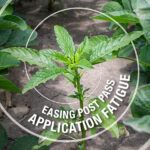Testing New Farm Technologies
Project Bin Buster tries out new technologies to help growers make data-based in-season decisions.

Last year, Syngenta partnered with representatives from four technology companies to test their new devices on commercial farms in Illinois as part of Project Bin Buster.
“We wanted to know whether or not these technologies would bring value to our company, our growers or both,” says Bill McDonnell, digital ag solutions lead for Syngenta. He also oversees the company’s Farm of the Future, 152 acres of land near Ottawa, Illinois, where crop production experts evaluate innovative yield-enhancement tools using the Project Bin Buster protocol.
In 2020, the Bin Buster project stretched across nearly 400 acres over five farms, including the Farm of the Future — three in west-central Illinois and two farther north. Each of the five fields in the project were approximately the same size and planted with the identical replicated trials that included a base rate of nitrogen.
The project put four new technologies, produced by different companies, through their paces.
I would use these technologies on my farm. At the end of the day, it’s all about finding solutions.
Technology Monitors Airborne Plant Pathogens
California-based Scanit Technologies provided its new instrument, the SporeCam™ 100 Sensor, for testing. Equipped with a cassette that runs a sticky tape, the sensor can collect, identify and report the presence of harmful airborne plant pathogens and deliver that data electronically both hourly and daily, according to Glenn Wanke, the company’s chief commercial officer.
The sensor, which also collects weather data, was calibrated to collect gray leaf spot and northern corn leaf blight spores, but it also caught thousands of southern corn rust spores.
“Going forward, if we can put these out in strategic areas and they work, they’ll provide real-time information for making chemical-application decisions,” says Brad Koch, a Syngenta agronomist and corn, soybean and wheat farmer near Quincy, Illinois, who oversaw the project on the three farms in his area. “For example, if we can accurately predict southern corn rust and treat it accordingly, growers could see a 20 to 30 bushel per acre yield increase.”
Drones Deliver Accuracy
Project participants used drones developed by Rantizo, a company in Iowa City, Iowa, to spray the recommended treatments. Autonomous hardware and easy-to-use software then confirmed that issues were addressed correctly, says Michael Ott, Rantizo’s CEO.
Miravis® Neo was mixed with Warrior II with Zeon Technology® and applied to half of each plot. The mix was applied by drones on the west-central locations and by a ground rig on the northern locations.
“There were stark differences between the treated and untreated areas from a yield perspective and a plant integrity standpoint,” Koch says. “The plants stood better; the ears were more intact; and the fields took less time to harvest.”
Ott adds, “The application of chemicals by drones is increasing because users can very precisely apply ag inputs when and where they’re needed. And there’s no potential for soil compaction or crop damage. Through this technology, growers can bring more efficiency to their operations.”
Prior to using the drone technology in the field, Rantizo received all required regulatory approvals from both the Federal Aviation Administration and the U.S. Environmental Protection Agency. A next step for Rantizo is rolling out a new automated mix and fill loading system.
Instrument Tracks Nitrogen Levels
The problem with conventional soil testing is that it’s done in the offseason, but growers have to make their nitrogen application decisions during the growing season — a scenario that can lead to less-efficient nitrogen use. Retailers and trusted advisers are instrumental in helping growers make decisions on fertility management. Sensors also may help with in-season applications. To further aid nutrient management, Project Bin Buster participants tested a wireless nitrogen, phosphorus and potassium (N-P-K) soil probe and its analytics platform.
Teralytic, a soil health company with four U.S. locations, developed the technology. “It’s a tool for making in-field, real-time nitrogen application decisions,” says Teralytic CEO Steve Ridder. “It also looks at soil health (carbon dioxide and oxygen), moisture, temperature, pH levels and salinity.”
“We looked at multiple nitrogen rates above and below the standard recommendations to try to pinpoint the return on investment from a fertilizer standpoint,” Koch says. “We used the data from the sensors to determine if we were making the right nitrogen fertilizer recommendations. In many cases, we applied more nitrogen than was originally planned.”
Grower Nick Andrew, who participated in Project Bin Buster and who has a 2,500-acre corn and soybean farm north of Quincy, Illinois, was most interested in the N-P-K sensor and the nitrogen fertility information he gleaned. “It looks like I was definitely overapplying it in some areas. In the future, I hope to cut back nitrogen use in some fields by 20%, which will save me around $20 per acre,” he says.
Moving forward, Teralytic will use the sensors to digitally measure on-farm carbon emissions. “Our goal is to help growers sequester excess carbon and then guide them in participating in carbon-trading markets,” Ridder says .
Sensor Provides Valuable Data
Giving growers the ability to track crop progress and quickly respond to any risks that emerge made testing the Arable Mark 2, an in-field sensor that acts as a weather station and crop monitor, a viable choice for the project.
“The Arable Mark 2 is rugged and self-contained, with no moving parts, and it has the ability to transmit data in any location with cellular connectivity,” says Adam Wolf, the founder and chief scientist of Arable, an ag and analytics company headquartered in San Francisco.
Among its 40-plus features, the sensor, which perches above the plant canopy, takes hourly surface-wetness readings to track disease potential, plus hourly dew and temperature readings. It also tracks canopy cover, which is used to estimate photosynthesis and growth, to monitor seasonal crop progress.
“After a fungicide with growth-regulating capabilities was applied, we were able to show that, in the treated plots, the greenness held on for quite a bit longer,” Wolf says. “That resulted in more photosynthesis, which, in turn, brought more dry matter into those growing kernels.”
Brad Koch adds, “From a research perspective, the Arable data will be helpful for making weather, soil moisture, temperature and plant health correlations in real time.”
What’s Next?
In 2021, Project Bin Buster will focus on corn again and add on-farm trials with two potato growers.
Steve Moffitt, the agronomy manager for D. Dowson Farms, an operation participating in Project Bin Buster, sees meaningful promise in these new technologies, “I would use these technologies on my farm. At the end of the day, it’s all about finding solutions,” he says.
4 Min Read
More Articles About Tech & Research
RECOMMENDED FOR YOU
4 Min Read























